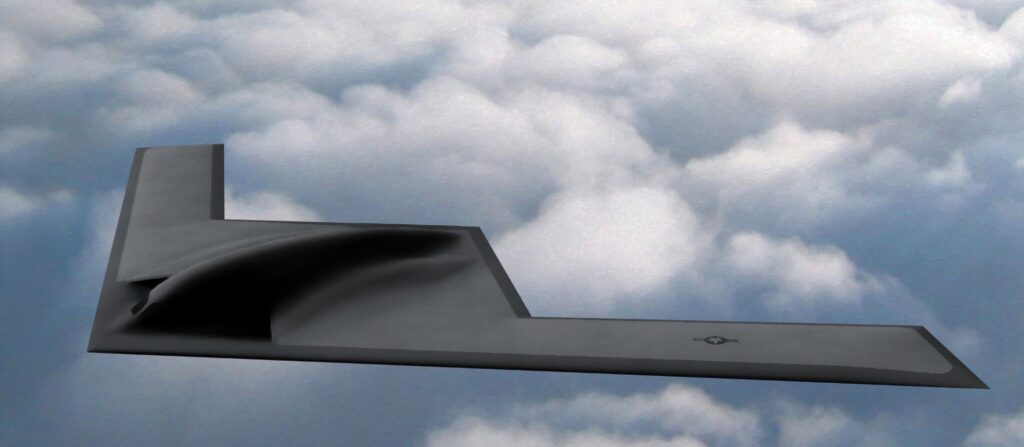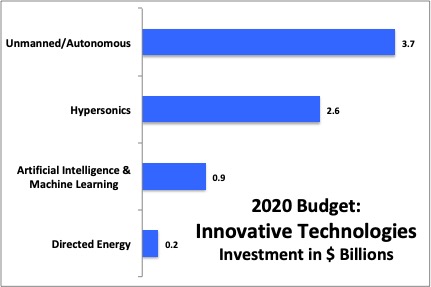2020 BUDGET: Airpower Wins Big; ‘Multi-Domain’ Emerges
Posted on

B-21 Raider artist rendering
CORRECTED & UPDATED from briefing PENTAGON: What does the US military need to win a war — or better yet, prevent one — against Russia or China? The answer in the 2020 budget request is planes and missiles.
[Click here for all our 2020 budget coverage]
At $57.7 billion, the “Air Domain” is the largest single category, by far, in the 2020 budget request’s list of major investments to “enhance competitiveness” with great-power rivals. Almost all of it is Air Force programs, with the F-35, despite cuts, still the largest single item.
That $57.7 billion for the Air Domain spending exceeds:
- The $34.7 billion for the “Maritime Domain” (i.e. Navy) by 67 percent,
- The $14.6 billion “Ground Systems” (Army and Marines) by 295 percent,
- The $14.1 billion for “Space” (mostly Air Force) by 309 percent,
- and, the $9.6 billion for sexiest of all domains, “Cyber,” by over 500 percent.
CORRECTED: While all the examples given in each category — except for some $3.7 billion in cyber offense & defense operations — are acquisition programs, Pentagon officials said at this afternoon’s briefing that the domain categories all include not only R&D and procurement but also associated operations & maintenance, military construction, and personnel costs.
And, yes, the budget documents invoke Multi-Domain Operations, a kind of super-jointness in which land-based missile launchers, robot warships, cyber warfare, and aircraft converge on the enemy from all directions in a fierce symphony of attacks. There’s even an investment category labeled variously “Multi-Domain” or “Multi-Domain & Nuclear Triad,” depending on the document. Of the programs actually identified in this category, all but one of them, the Navy’s Columbia-class ballistic missile submarine, belong to the Air Force. The largest item listed under “multi-domain & nuclear” is the Air Force’s B-21 bomber, which will have secondary missions in nuclear and perhaps cyber warfare but is believed to be primarily designed to penetrate Chinese and Russian air defenses and drop conventional precision weapons.
UPDATED Other investment categories are a bit more balanced. $13.6 billion for “Missile defense and defeat” — while not a domain co-equal to the official five of land, sea, air, space, and cyberspace — includes a mix of Navy AEGIS, Army THAAD and Patriot, and Missile Defense Agency GMD
The Pentagon’s $7.5 billion of investments in “innovative technologies” likewise cut across all the services:
- $3.7 billion for unmanned & autonomous systems, i.e. drones and robots in layman’s language;
- $927 million for Artificial Intelligence & machine learning, which is essential for robotics but goes well beyond it, with applications to intelligence analysis & targeting, operational planning, and cyber/electronic warfare;
- $2.6 billion for hypersonic missiles, to include multiple Air Force prototypes, the Navy’s Sea-Launched Conventional Prompt Strike program, and the Army’s Land-Launched Conventional Prompt Strike;
- $235 million for directed energy, which mostly means lasers — something all the services are looking at for missile defense — with a dash of high-powered microwaves.
But these investments still pale beside the F-35 Joint Strike Fighter, still the largest conventional weapons program in US history. When it comes to future warfare, the Pentagon’s vision still boils down to massive investments in airpower. That’s despite increasing concerns that China and Russia have focused their own investments precisely on keeping our airplanes at bay, even the stealth aircraft — an approach known as Anti-Access/Area Denial — and on disrupting the globe-spanning networks required to coordinate them — through cyber and electronic warfare.
Part of the predominance of airpower may simply be that the Air Force has more big-ticket programs that are both relevant to great power war and far enough along to be “shovel ready” to pour more money in. By contrast, the Navy is still fighting to protect its carrier fleet — which the Pentagon leadership increasingly sees as too vulnerable for a war with China — and is just starting to invest in the robotic ships of “Navy 2.0,” while the Army’s own Big Six investments are likewise still in prototype. When the Navy and Army have more programs ready for production, we might see a shift — but that won’t be this year, or next.
In the near term, the most important actions on the 2020 defense budget are yet to come — decisions over which the Pentagon can exercise relatively little control: What will Congress do? Generally speaking, it’s a fair assumption that the Democrats, who control the House, will resist the request increase in defense spending, both because it’s offset by steep cuts to domestic spending and because bypasses Budget Control Act caps by shifting substantial funding into Overseas Contingency Operations. While more and more OCO funding has been used for “base budget” needs, it is supposed to pay for wartime operations and emergency spending and Democrats have already said they will oppose what they consider a budget gimmick.
[Click here for all our 2020 budget coverage]
Colin Clark contributed to this article.
Subscribe to our newsletter
Promotions, new products and sales. Directly to your inbox.


